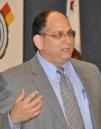Don’t Count Your Raindrops Before They Fall
I am not a meteorologist, but every time I see, read or hear a story about “El Niño” this year I get a little worried. We know that the Pacific Ocean temperature is rising in a pattern that we have come to call El Niño. And history tells us that often means increased precipitation in California’s coming winter season. But when that rain will come, where it will fall, and over what period of time are questions that are impossible to answer. There are just too many variables for any model, algorithm or Old Farmer’s Almanac to accurately forecast.
Of course, we all hope that El Niño will arrive slowly over the course of several months with reservoir-filling, ground-water-replenishing, crop-enhancing rains that fall gently to earth. We want to go back to not having to think about every drop of water we use. We want this to be the end of the drought. But if El Niño is coming, it may not happen when, where or how we want it to.
El Niño events often mean heavy rainfall in short time spans ushered in on the “pineapple express” — warm storms that melt any previous Sierra snowfall and cause flooding downstream. Does anybody remember 1986 and 1997? In both of those years, El Niño events caused severe flooding, lots of damage and some loss of life.
You know, I apologize. I’m not trying to be such a downer. I know we need water badly and if you’ll pardon the pun, I’m not trying to rain on El Niño’s parade. But I do think it’s important to be a realist. We have seen this week in Southern California what can happen when too much rain falls all at once.
The likelihood that El Niño will arrive in the right place, at the right time and in the right way to erase the drought and spare us the negative effects of flooding is low.
The forecasts are not certain and I hate to think of people easing up on conservation because “El Niño will save the day, so why bother?” I also hate to think of people who, after so many years of drought, may not even know they live, work or drive through flood-prone areas—let alone have made any preparations for such an event. And this is still July. What are November and December going to look like? Or January and February next year? Who knows?
And that is my point. We can measure the temperature of the ocean and make an informed forecast that we’ll get more rain than usual this winter, but we have no way of knowing what that really means for the drought or our personal safety. So despite the El Niño forecasts, this is not the time to stop conserving water. It IS the time to think about taking some steps to reduce your personal flood risk. And if that advice, “save water/prepare for flooding” sounds a little bipolar—welcome to California!












































